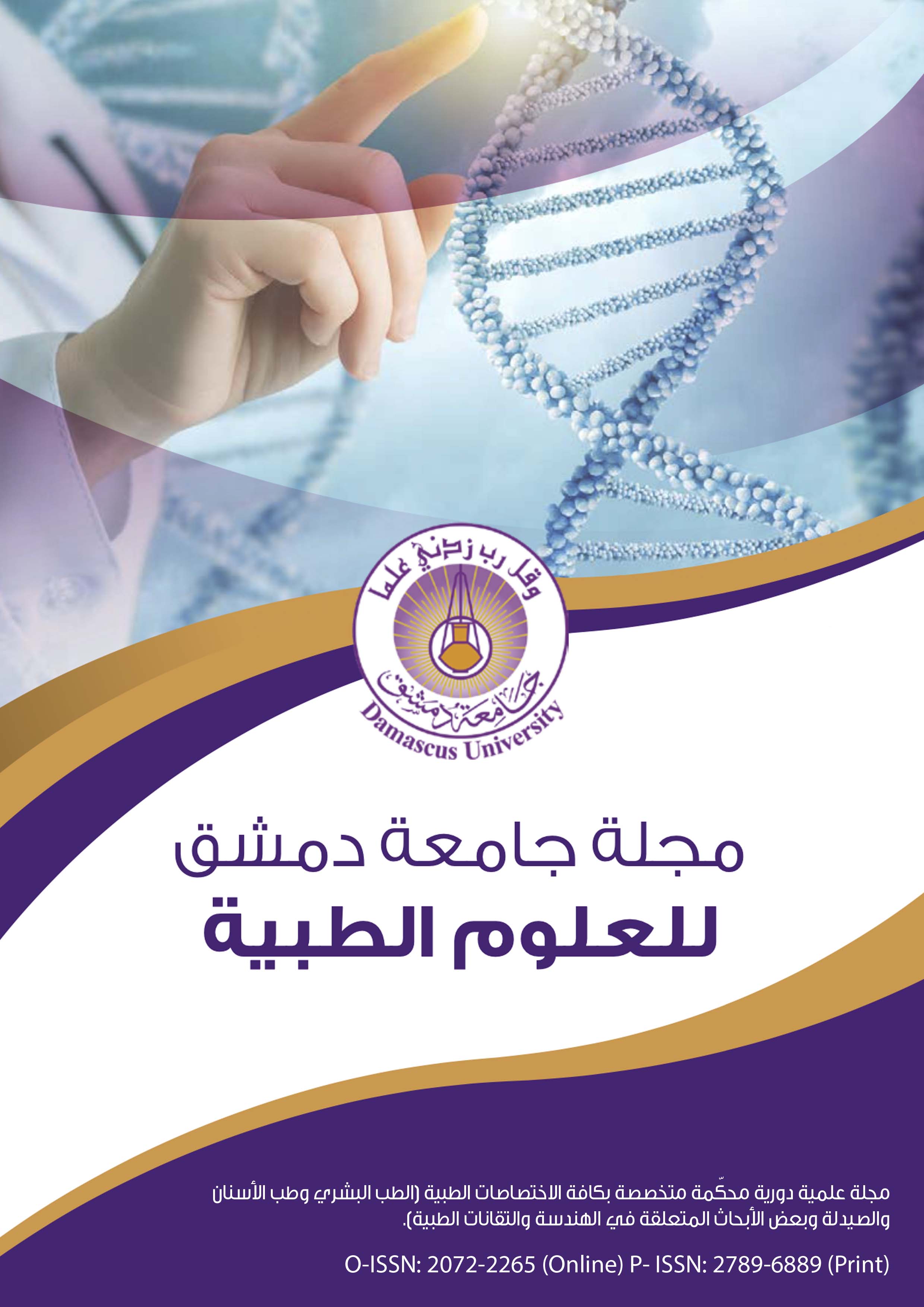عوامل الاختطار لداء كوفيد-19 الشّديد والحرج لدى جمهرة من السوريين:دراسة مقطعيّة استعاديّة
الكلمات المفتاحية:
داء الفيروس التّاجي 2019، عوامل الاختطار، الشدّة، العمر، البدانة، داء مصاحب، ارتفاع التّوترّ الشرياني، السّكّريالملخص
الملخص:
خلفية البحث وهدفه: تسبّبت جائحة داء الفيروس التّاجي 2019 (COVID-19) بمستويات غير مسبوقةٍ من المراضة والمواتة في جميع أنحاء العالم، واتسم المسار السريري للمرض وطيف محصلاته بالتباين بين الأفراد والأعراق والإثنيّات من حيث الشدّة ابتداءً بالعدوى اللاعرضيّة والخفيفة إلى المرض الشديد والحرج وصولاً إلى الوفاة. هدفت دراستنا إلى استعراف عوامل الاختطار المتعلّقة بالمضيف والمرتبطة بشدّة الإصابة بعدوى كوفيد-19 لدى جمهرةٍ من البالغين السوريين من الجنسين ومن فئات عمريّة مختلفة.
الطّرائق وأفراد الدّراسة: صُمّمت هذه الدّراسة لتكون مقطعيّة استعاديّة معتمدة على استبانة نُشِرت إلكترونيّاً بين شهري تموز وأيلول من عام 2021، تلاها إجراء مقابلات مع الأفراد الذين أتموا ملء الاستبانة بهدف التثبّت من البيانات الديموغرافيّة وشدّة أعراض العدوى بـ كوفيد-19 والأمراض المرافقة ونتائج الاختبارات والمقايسات المخبريّة المعتمدة في التّشخيص. صُنّف المرضى من حيث شدّة العدوى بـ كوفيد-19، اعتماداً على المرشدات العلاجيّة لـ كوفيد-19 الصّادرة عن المعاهد القوميّة للصحّة (NIH) الأمريكيّة، في أربع فئات خطورة؛ (مرض لا عرضي/خفيف، متوسّط الشدّة، شديد، حرج). اعتمدت برمجيّتا إكسل (Microsoft Excel) وGraphPad Prism بنسخته 6.01 لإجراء الاختبارات الإحصائيّة والتّمثيل البياني، واعتمد مستوى الدّلالة الإحصائيّة عند قيمة p=0.05.
النّتائج: بلغ عدد المشاركين مؤكّدي التّشخيص 170 فرداً وبنسبةٍ أعلى للإناث (54.71%). صُنّف 37 مريضاً (21.76%) في فئة "العدوى الشديدة" وحقّق 16 مريضاً (9.41%) معايير "المرض الحرج". وبلغت نسبة الاستشفاء 34% توزّعت بين 21/38 (55.21%) حالة عدوى شديدة وجميع الحالات الحرجة 16/16 (100%). شكّل الشّباب (<50 عاماً) الفئة العمريّة المهيمنة (71.18%) ولم تتعدَ نسبة المسنين (65≤ عاماً) 12.94%. تصدّر طيفَ الأعراض والشكايات كلٌّ من التعّب/الوهن العام (75%) متبوعاً بفقدان حاسة الشّمّ و/أو التذّوق (51.19%). كانت غالبيّة مرضى العداوى الحرجة زائدي وزن (BMI ≥25 كغ/م2) (81.25%) ومشخصين بارتفاع توتّر شرياني (75%) و/أو داء السكّري (37.5%)، ومسنين (65≤ عاماً) (68.75%)، مقابل نسبٍ أدنى لدى مرضى العداوى الشّديدة ومتوسطة الشّدة والخفيفة، وبفوارق ذات دلالةٍ إحصائيّة (p<< 0.05 لجميع المقارنات). ارتبطت العداوى الشديدة والحرجة بكلٍّ من التّقدّم بالعمر (yeas 50≤) (Odds Ratio [OR]= 6.597, 95% CI 3.160-13.775, p= <0.0001) ، (65 years≤ (OR= 21.748, 95% CI 6.049-78.188, p= <0.0001) ، وزيادة الوزن (BMI ≥25 كغ/م2) (OR= 2.256, 95% CI 1.139-4.467, p= 0.0197)، أو البدانة (BMI ≥30 كغ/م2) (0.0019 OR= 2.256, 95% CI 1.139-4.467, p=)، وأدواء مزمنة مصاحبة كان أهمّها ارتفاع التّوتّر الشرياني (OR= 6.3793, 95% CI 2.9849-13.6340, p< 0.0001) وداء السّكري (OR= 9.750, 95% CI 2.989-31.808, p=0.0004).
الاستنتاجات: تزداد احتماليّة داءCOVID-19 الشّديد والحرج مع التّقدّم بالعمر وزيادة الوزن أو البدانة ووجود أمراض مصاحبة مزمنة (بصورةٍ رئيسيّةٍ ارتفاع التّوتّر اشرياني والسّكّري والأمراض القلبيّة الوعائيّة). تسهم هذه الدراسة في استعراف منبئات شدّة كوفيد-19 وتصنيف المرضى السوريين بناءً على درجة الاختطار المتوقّعة، ومن شأن ذلك أن يغذّي عمليّة اتخاذ القرار العلاجي من قبل مقدمي الرّعاية الصّحيّة.
الكلمات المفتاحيّة: داء الفيروس التّاجي 2019، عوامل الاختطار، الشدّة، العمر، البدانة، داء مصاحب، ارتفاع التّوترّ الشرياني، السّكّري.

